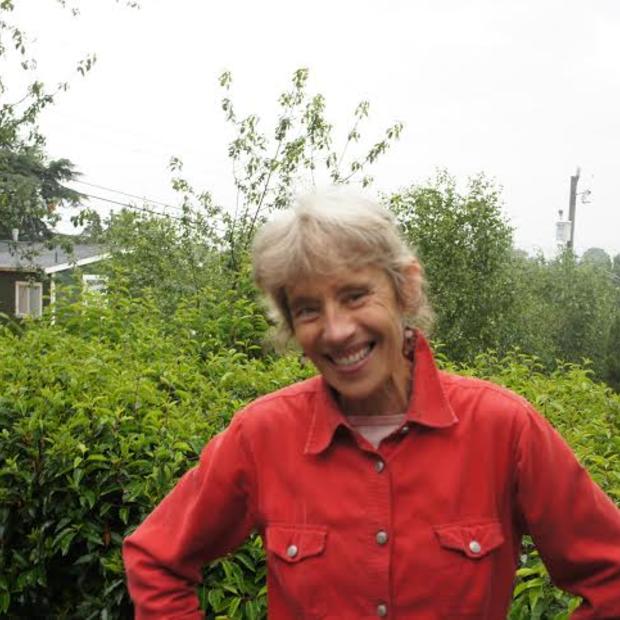Particles and Half-Lives is a new exhibit at the University of Washington that looks at the Hanford Nuclear Reservation through the eyes of artists and poets. Hanford, you ask? Isn’t that history? Not quite. The most contaminated nuclear waste site in the Western Hemisphere has a long way to go before its toxic legacy is no longer a threat to the environment and public safety.
Click on the audio player above or here to listen.
Particles and Half-Lives, an exhibit now on view at the UW's Odegaard Library, looks at the birthplace of the atom bomb, Hanford, in Richland. Artists, poets and scientists explore the legacy of the Western Hemisphere’s most contaminated nuclear site with stories of workers exposed to radiation and families transformed by sickness and loss. The exhibit warns that Hanford’s toxic legacy lives on.
Poet Nancy Dickeman grew up in Richland. She reads from "Trigger Mechanics": "The storage tanks, holes cracked, leak into the shrub stepped earth, a meandering tilt toward groundwater. Workers toil building a vitrification plant to turn radioactive waste into glass logs, as if it were magic except the still tick beneath the Geiger counters metal hand."
Hanford’s impact on the world is huge, says Steve Gilbert, an environmental health and nuclear disarmament advocate. He, Dickeman, and others conceived of the exhibit to keep Hanford in the public eye. Hanford supplied plutonium for bombs dropped on Nagasaki and Hiroshima. Today it supplies plutonium for the largest concentration of nuclear subs in the world, notes Gilbert, the Trident Nuclear Submarine Base, at Bangor on the Kitsap Peninsula. “We do not need Trident submarines full of nuclear weapons. We need to focus on cleaning up Hanford which has the potential to contaminate the Columbia River.”
Irradiated fuel waste continues to leak from Hanford’s nuclear reactors. Gilbert says, “We don’t have a good way to store the irradiated waste fuel rods that come out of those reactors. They’re not being dry cast enough and that’s a story across the United States.”
“Hexavalium chromium. Strontium 90.” Musician and activist Ashley Douglas sings in “Hanford Hot Spots.” “This sludge remains at the bottom of Miss Columbia, the almighty.” Written with Jacinta Heath, a UW student writing her honors thesis on Hanford, the duo’s goal is to raise awareness, particularly among young people. “Because it’s so shocking that this is right over the mountains and people aren’t engaging with it. And I guess the big thing is that historic culture of secrecy around the site.” Both speak of their Native American heritage and desire to honor their culture and shed light on questions that have long gone unanswered.
Hanford’s risk to the population as a whole remains high, says Tom Carpenter. He directs the Hanford Challenge, a non-profit committed to clean up the site and protect whistleblowers or workers from being silenced when they see safety compromised. “We’re at a point in time right now where numerous workers are warning the public and warning officials in the Department of Energy that shortcuts are being taken on safety.” Carpenter says shortcuts include the design of a plant that will turn high level nuclear waste into glass. If the waste isn’t mixed correctly there’s a potential for a hydrogen gas explosion.
The EPA, Department of Energy and State of Washington have an agreement to clean up Hanford through 2052. But they’re behind schedule, says Carpenter, and unwilling to spend the billions needed to do the job. “The U.S. spent $5.5 trillion dollars to make nuclear weapons according to the Brookings Institution so that clean-up cost is actually quite small compared to the defense cost of making nuclear weapons.”
“I think the thing that drives me more than anything is this place might get forgotten,” says poet Kathleen Flenniken, who grew up in Richland. She worked as a hydrogeologist at Hanford in the 80’s. Since then she’s grappled with the set of truths she grew up with versus those she now understands. She reads from her poem, “Plume,” heard here in part. It will be published as a book of poetry by the University ofWashington Press this month. “It is out of our hands. This fifty year mistake. This poison. Yes it is moving to the river. Yes it migrates between grains down to saturated sediment. And like anything with a destiny, a flock of birds, sperm, breath, it will move downstream to the river, yes the river will take it in.”
If you go: The exhibit, Particles on the Wall, runs through March 29 at Odegaard Undergraduate Library on the UW Campus. Hours are here.
Green Acre Radio is supported by the Human Links Foundation. Engineering by CJ Lazenby. Produced through the Jack Straw Foundation and KBCS.



